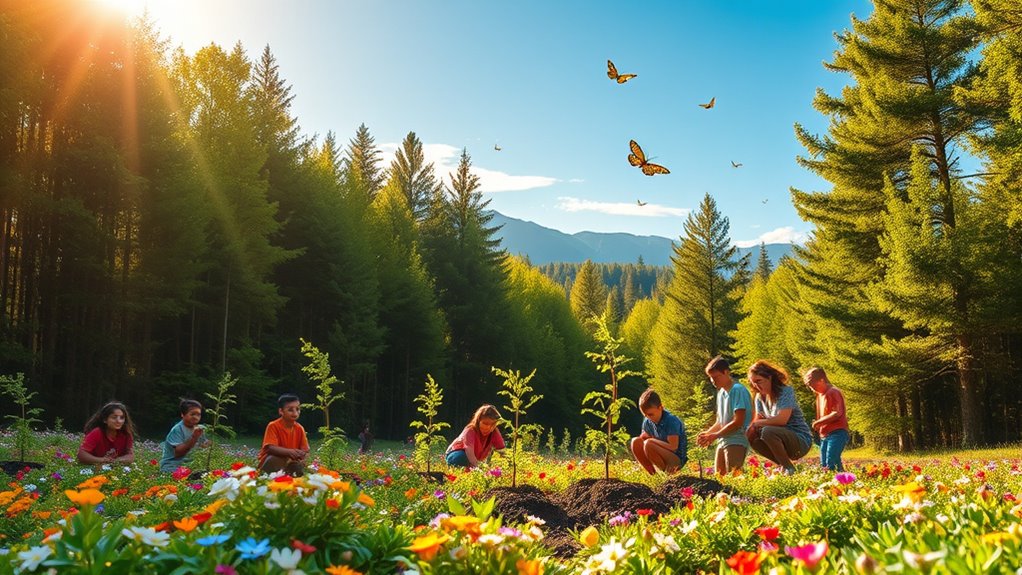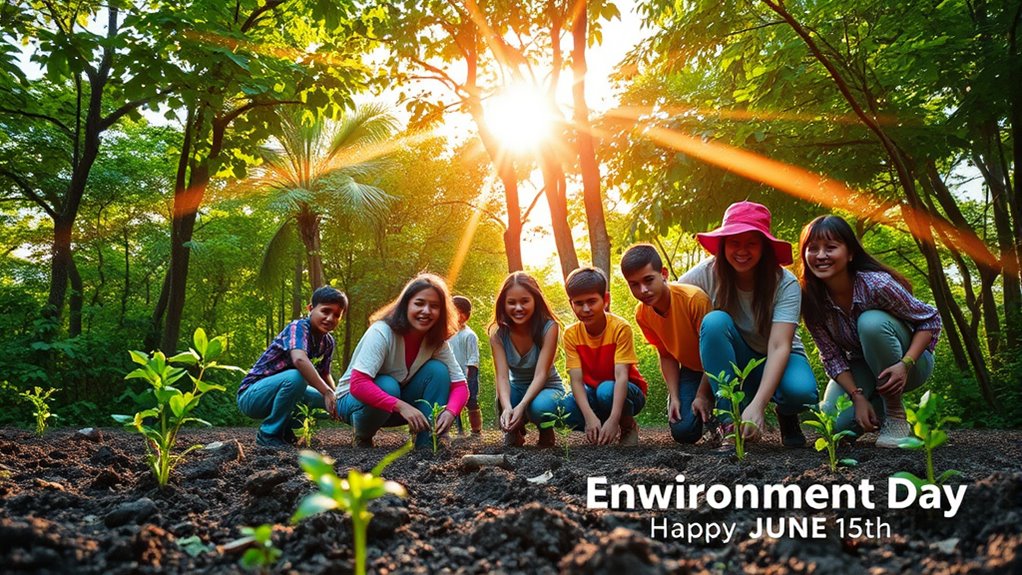World Environment Day, celebrated every June 5th, was established in 1972 by the United Nations during the Stockholm Conference to raise awareness about environmental issues. This day highlights the importance of conservation, biodiversity, and sustainable practices, encouraging individuals and communities worldwide to take action. Each year, a new theme guides global efforts against climate change and pollution. By understanding its history and significance, you’ll see how collective efforts can make a real difference—learn more about how you can help.
Key Takeaways
- Established in 1972 by the United Nations during the Stockholm Conference to raise environmental awareness.
- Celebrated annually on June 5th to promote global environmental protection and sustainable practices.
- Each year features a specific theme to address current ecological challenges like climate change and deforestation.
- Acts as a platform for individual, community, and governmental actions such as tree planting and waste reduction.
- Reinforces the importance of conservation, biodiversity, and collective responsibility in safeguarding the planet.

Every year on June 5th, millions of people worldwide come together to celebrate World Environment Day, a global initiative that reminds us of the urgent need to protect our planet. This day marks a powerful call to action, highlighting how individual and collective efforts can combat critical issues like climate change and promote conservation efforts. You might wonder how a single day can make a difference, but the truth is, it’s a catalyst for raising awareness, inspiring change, and fostering a sense of responsibility among communities across the globe. When you participate in activities such as planting trees, reducing waste, or advocating for policies that protect natural resources, you contribute to a broader movement aimed at safeguarding our environment for future generations.
Every June 5th, millions unite to protect our planet through awareness, action, and conservation efforts.
The roots of World Environment Day stretch back to 1972, when the United Nations established it during the Stockholm Conference on the Human Environment. Originally focused on raising awareness about environmental issues, the day has evolved into a platform that emphasizes the importance of tackling climate change head-on. Climate change, driven by greenhouse gas emissions from burning fossil fuels, deforestation, and industrial processes, poses one of the greatest threats to ecosystems and human societies alike. As an individual, your actions—like reducing energy consumption, supporting renewable energy sources, or advocating for climate policies—are vital parts of a larger puzzle. Conservation efforts, whether through protecting endangered species, restoring natural habitats, or reducing plastic use, help mitigate these effects and preserve biodiversity. Every small effort adds up, creating ripple effects that influence larger systemic change.
Throughout the years, each World Environment Day has focused on different themes to address specific environmental challenges. These themes serve as rallying points for action, urging governments, businesses, and citizens like you to prioritize sustainability. The day offers opportunities to educate yourself and others about sustainable practices, encouraging you to rethink your habits and embrace more eco-friendly choices. Participating in local clean-ups, supporting conservation projects, or simply spreading awareness on social media can amplify the message and motivate others to join the movement. Additionally, advancements in environmentally friendly technologies, such as high-efficiency projectors, demonstrate how innovation can support sustainability goals. Recognizing the role of public awareness in driving change is essential for long-term environmental success. Moreover, understanding the interconnectedness of all life on Earth underscores the importance of biodiversity preservation for a resilient planet. Research shows that climate change impacts are accelerating faster than previously predicted, emphasizing the urgency of collective action. Remember, climate change isn’t an isolated issue; it’s intertwined with every aspect of life on Earth. Your commitment to conservation efforts can help slow its progression and protect vulnerable ecosystems.
In essence, World Environment Day is more than just a date on the calendar. It’s a reminder that everyone has a role in creating a healthier, more sustainable world. Your actions, no matter how small, contribute to global efforts to combat climate change and conserve the planet’s resources. By recognizing the significance of June 5th, you participate in a powerful tradition of environmental stewardship that can inspire change and ensure a better future for all. Understanding the history and significance of this day can help deepen your commitment to ongoing environmental initiatives.
Frequently Asked Questions
How Did World Environment Day Originate?
You might wonder how World Environment Day originated. It started as a response to increasing environmental awareness and the need for global initiatives to protect our planet. In 1972, the United Nations organized the first celebration, encouraging countries worldwide to focus on environmental issues. Since then, it has grown into a global movement, inspiring millions to take action and promote sustainable practices for a healthier Earth.
Who Founded World Environment Day?
Did you know that the United Nations officially founded World Environment Day in 1974? As someone passionate about environmental activism and conservation efforts, you might find it inspiring that the UN aimed to encourage global awareness and action. The day was established by the UN General Assembly, emphasizing the importance of collective responsibility. You can participate and make a difference, supporting initiatives that protect our planet for future generations.
Which Countries Have Hosted the Most Celebrations?
You’ll find that countries like India, Nigeria, and the United States have hosted the most celebrations, showcasing their environmental leadership. These nations often lead with innovative celebration traditions, raising awareness through community events, cleanups, and educational activities. By hosting frequently, they set powerful examples and inspire global participation. Their dedication highlights the importance of collective action, motivating others to join in protecting our planet on this significant day.
How Is the Theme for Each Year Selected?
Think of the theme for each year as a guiding star in the night sky, illuminating the path to greater environmental awareness. The United Nations selects it based on pressing global issues and conservation initiatives, aiming to inspire collective action. Experts and partner organizations propose themes, which are then reviewed and approved to guarantee they resonate worldwide, motivating everyone to protect our planet and make sustainable choices.
What Are Some Notable Global Environmental Campaigns on June 5th?
On June 5th, you can participate in global environmental campaigns that highlight corporate responsibility and youth activism. These campaigns often feature protests, awareness drives, and social media challenges encouraging businesses to adopt sustainable practices. Youth activists lead marches and campaigns to push governments and corporations to prioritize eco-friendly policies. Your involvement helps amplify these messages, showing that collective action can drive meaningful change for a healthier planet.
Conclusion
As you celebrate World Environment Day, remember it’s like planting a seed for a greener future. Your small actions today can grow into mighty trees of change tomorrow. Just as a single drop creates ripples across a pond, your efforts can inspire others to protect our planet. Embrace this day as a reminder that together, we hold the power to turn the tide and nurture the Earth we all call home.










